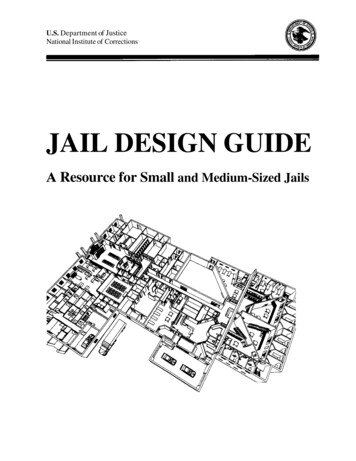
Transcription
U.S. Department of JusticeNational Institute of CorrectionsJAIL DESIGN GUIDEResource for Small and Medium-Sized Jails
National Institute of CorrectionsL.DirectorProject ManagerMichael A.Tom Reid, Project Manager
JAIL DESIGN GUIDEA Resource f o r Small and Medium-Sized JailsProject DirectorDennis A.A.I.A.Associate Project DirectorGary M . Bowker, Corrections SpecialistProject StaffRobert G . Deichman, R.A.David E. Bostwick, A.I.A.James R. Rowenhorst, Corrections SpecialistThis project was supported by grant numberfrom the NationalofCorrections,Department of Justice. Points of view or opinions stated in this documentare those of the authors and do not necessarily represent the official position or policies ofthe U.S. Department of Justice.November
1998. Kimme Associates, Inc.807% S. NeilChampaign, 61820217-351-7036The National Institute of Corrections reserves the right to reproduce, publish,or otherwise use,and to authorize others to publish and use, all or any part of the copyrighted material contained in thispublication.
TABLE OF CONTENTSAcknowledgements.ForewordxAbstract.1 Background1-1History.1-2Lessons from Experience.1-3Intended Audience.Contents ."Better" Jails .Operations and Design .Construction Details.2 Pre-Design Planning2.1Reasons for Planning .Can a Prototype Replace the Need to Plan? . 2.3Planning Steps.PhaseNeeds, Options, and CostAssessment .2-5Phase 2: Facility ProgramWhen Planning Works Well2-10.3 Major Design Considerations3.1SiteSite Size .3.2Site Location.3-7Site Costs .3.1113Site Selection ProcessExteriorInteriorDescribing Desired Appearance153-151618Separation ProblemsClassification SystemsResolving the Numbers ProblemDesigning for Proper Separation193. 193.223.233.24
.3.333.33Methods ofDesign Considerations .3.35Staffing Impact .3.48Legal Issues .3.493.4924-Hour CoverageDesign Factors .3.503.59Security PerimeterIngredients of Security .3.59Perimeters and Zones.3-61Design Considerations . 3.64Conclusion.3-74Criminal Justice Interface3-75A General Caution3-75Law Enforcement Interface3-76Courts Interface .3-81Attorneys.3-84.3-85.Conclusion3-85Functional Componentsand Relationships3-86Jail Components .3.86Degrees of Development .3-88Component Relationships.3-90Space-Sharing Possibilities.3-94Conclusion.3-96Planning Designing to Standards3.97State Standards.3-97ACA Commission on AccreditationStandards.3-98NFPA Life Safety Code.3.99Americans with Disabilities Act . 3.99101ConclusionExpansion . 102Why Plan for Expansion?Expansion Options.3-1023-103When to Develop an Expansion PlanSetting Expansion CapacityVertical vs. Horizontal Expansion . 3-104Conclusion.3-107
.4 Detail Functional Components.4.1Master Control. . .Key Decisions.Detail Issues4-3Space List . 14Relationships . 14Component Diagram. 15Intake-Release. .16. 16Key Decisions.4-18Detail Issues . 19Space List .4.42Relationships4-43Component Diagrams .4-43General Housing4.44Description4.44Key Decisions4-45Detail Issues .4-46Space List .4.814.82Relationships4.82Component Diagram4-83Special HousingDescription4-83Key Decisions4-84Detail Issues4-85Space ListRelationshipsComponent Diagrams . 102Health CareDescriptionKey DecisionsDetail IssuesSpace ListRelationshipsComponent DiagramVisiting AreasDescriptionKey DecisionsDetail IssuesSpace ListRelationshipsComponent Diagram4-1044-1064-1194-1204-1201211214.1221314. 132132
Exercise Areas . 133Description. 133Key Decisions. 133Detail Issues .4.134Space List . 145Relationships.4-146Component Diagram.4-147. 148. . .4.148Key Decisions.Detail IssuesSpaceRelationshipsComponent Diagram4-1644-1651654-166Inmate CommissaryDescription166Key Decisions166167Detail Issues4-170Space ListRelationships. 1704-170Component DiagramFood Service4-171Description.4-1714-172Key DecisionsDetail Issues .4-172Space List4-180Relationships. 181Component Diagram. 181Laundry Area . 182Description1824-182Key DecisionsDetail Issues . 182Space List .4-187Relationships. 4- 88Component Diagram. 188. 189Description4.189Key Decisions. 1904.190Detail IssuesSpace List .4.202Relationships.4.203Component Diagram
Staff Areas .4.204Description.4.204Key Decisions.4-204Detail Issues .4.205Space List.4.2 15Relationships .4.2 16Component Diagram. 4.2 16Storage Areas4.2 17. . . 4.2 17Key Decisions. 17Detail Issues4.2 17Space List.4.224Relationships.4-225Component Diagram.4-225.5 Special ConsiderationsSingle vs. Multiple OccupancyDefinitions5.2Standards and Legal Issues .The IssueSingle Occupancy: Two Concerns . 5.5The Costs of Multiple Occupancy5.6DoubleSingle Cells5-7ConclusionRenovating Non-Secure Buildings into JailsA Common Renovation ExampleSecurity struction and Project CostsConstruction CostsProject CostConclusion5-165-165-19.6 Making a Building Work.Policy and Procedure DevelopmentFinal Staffing Plan and Staff Post OrdersBudget Preparation and Approvaland SelectionStaff TrainingMove Logistics6-26-26.36.46-4
ACKNOWLEDGEMENTSThe project team is indebted to the National Institute of Corrections (NIC)for the opportunity to revise and update the original Small Jail DesignGuide, now ten years old. It was a large and complicated undertaking then,but one that provided its authors with many rewards based on itsdocumented value to planning professionals and local officials alike.Small Jail Design Guide, they would have been without aWithoutsubstantial planning and design resource as they undertook major projectsinvolving millions of dollars in construction and jail staff time.As with the first edition, the project team is enormously indebted to Michaelformer NIC Jails Division Chief, for his stewardship of thiscomplicated and lengthy project. His patience, professionalism, andcommitment to a quality end-product were a major driving force during thecourse of the work. Thanks also to Tom Reid, NIC Project Monitor at thedocument's conclusion, for his review assistance and guidance, and toNancy Sabanosh, NIC Publications Manager, for her superb editorial andattention to the endless revisions isproduction assistance. Sue Vangreatly appreciated. Finally, recognition must again go to many current andformer NIC Jails Division staff who invested considerable time in reviewingand improving the document.
FOREWORDNew jail construction is a major capital undertaking, which often representsthe single largest project in which county officials will ever be involved.Many local jurisdictions are replacing outdated facilities as well as expandingto accommodate increasing numbers of inmates. The U.S.Department of Justice Bureau of Justice Statistics reports the capacity of thenation's jails increased by approximately 20,000 beds during the year ending June 30, 1997.To respond to local jurisdictions' need for assistance in jail planning anddesign, the National Institute of Corrections offers a Facility DevelopmentProgram that provides guidance as they proceed with jail planning, design,construction, and transition. This document supports the Facility Development Program by providing information about basic concepts and issuessurrounding jail design.This document is a revised and expanded version of the Small Jail DesignGuide published in 1988. It now includes information relevant to planningfor both small and medium-sized jails. Based on information from surveyGuide authors, the documentrespondents and analysis by thediscusses current correctional standards and architectural principles that areimportant to building a cost-efficient jail to meet a locality's particular needs.While plainly written, it is sufficiently technical and detailed to guide localofficials, architects, and planners who may be unfamiliar with jail design,construction, and operational issues. It does not, however, include samplefloor plans as that would imply the recommendation of model solutions tojail planning and design issues. Each jurisdiction needs to craft a jail designto meet its unique situation and community needs.The information presented here will be beneficial to anyone involved inplanning, design, and construction of a new small or medium-sized jail -sheriffs, county commissioners, jail administrators, local directors ofcorrections, criminal justice planners, and interested citizens. This documentcanlocal officials assume and retain control of this important processand direct it toward the most beneficial solution for their community.Morris L. Thigpen, DirectorNational Institute of Corrections
ABSTRACTThis work is an updated version of the Small Jail Design Guide originallypublished in 1988. It updates and expands upon the original work, addingnew and revised graphics. It removes dated references to standards andadds several new sections. The illustrative designs at the end of the originalSmall Jail Design Guide are not included in this edition.In reviewing thedocument it was realized that many of the conceptsdiscussed apply equally to most jails, including those regarded as mediumsize (100 to 200 beds). Thus, after appropriate editing, the document wasrenamed Jail Design Guide: A Resource for Small and Medium-Sized Jails.In 1985, Kimme Planning and Architecture (now KimmeAssociates,Inc.) compiled surveyon 255 jails of 50 beds or less ("smalljails") that had been opened since 1974. In addition to survey information,on-site evaluations of 32 of those facilities were conducted to discuss andevaluate specific operational issues with administrators and staff. Thiswork identified the nature of the facilities and what "worked" about themand what did not. The data revealed that many new facilities suffered froma variety of design flaws and operational problems. Certain design featureswere identified as driving factors in the general operational "success" or"failure" of new small jails as perceived by staff and others charged with theadministration and funding of these facilities.Survey and site visit findings were reported in the Nature of New SmallJails: Report and Analysis released in 1985. In conducting the survey, theproject team identified several key planning issues that were problematic andappeared to cause difficulties for many responding jurisdictions. A total ofnine issues were analyzed in a separate NIC publication entitled SmallSpecial Issues released in 1986. Taken together, these two documentsrepresented Phase One of the NIC grant project.The first edition of the Small Jail Design Guide represented the end-productof Phase Two of the project. Since numerous NIC-sponsored documentsand training curricula had already explored the pre-design planning process,this document attempted to avoid duplicating those discussions. Rather, itsought to identify and describe those issues and architectural considerationsthat directly assist the development of an efficient, standards-compliant, andfunctionally effective design.In filling the void of design-oriented information available to small andmedium-sized jails -- and jails in general -- the Jail Design Guide exploresthe broad operational questions that drive a jail design and the specificoperational and design issues that must be addressed for each functionalcomponentfood services, housing). Architecturalresponses to the issues are closely integrated with operational data as a wayof illustrating the link between jail activities and physical space design.
BACKGROUND
BACKGROUNDThis second edition of what was originally titled the Small Jail DesignGuide is, as was its predecessor, an information resource intended to helpjurisdictions create better and more effective jails. It attempts to do this byproviding information concerning the important elements and concepts ofsuccessful jail design.One important change in this edition from the original Small Jail DesignGuide is that the audience it addresses has been expanded. Whereas theoriginal documented targeted "small jails," which were defined as having 50beds or less, this edition targets small and medium-sized jails. These aredefined as facilities up to 200 beds in size.The focus of what is now simply entitled the Jail Design Guide was broadened for two reasons:increases in local jail populations have significantly reduced thedemand for new jails of only 50 beds or less; andreflection and feedback on the First edition have made it clear thatmost of the issues raised in the original document apply equally wellto medium-sized facilities in the 100- to 200-bed range.The document was not redefined as an "all-jail design guide," because therejails andare still some fundamental differences betweenlarge jails or systems of facilities found in major metropolitan areas. Thesefundamental differences were found in many areas, a key one, for example,being the challenge of designing to accommodate inmateseparation needs. Large systems can respond by devoting entire housingor evenfacilities. to different classifications while stillTheandcalls forclassification-separation needs are the subject of condesigning forsiderable discussion in this document, as are many other special designchallenges that result from lesser scale and more limited resources. Havingestablished these distinctions of size, it must be said that many readers ofthe original Small Jail Design Guide still found it helpful in designing largejails since many basic issues explored do indeed apply to all jails.The design guide avoids re-creating information that already exists in otherareas of importance to small and medium-sized jails. Specifically, thedocument does not present detailedon the pre-design planningprocess, inmate supervision approaches, or staff training and needs analysissince other excellent resources on these topics already exist. However,since these and otherissues so greatly affect design, theirinfluence is acknowledged and expressed throughout this document. One
of the main philosophies of the Jail Design Guide is that planning andoperational issues cannot be. separated from design and, in fact, shape allthat a design becomes.HISTORYPROBLEMSRECOGNIZEDas well as other professionals in the field, became increasingly aware thatsome very ineffective and outdated small jails were being designed andattention because they created manybuilt. These facilities came toproblems and controversies for their owners and operators. These problems and controversies generated numerous technical assistance requests toNIC, and it was often the case that little could be. done to correct majorflaws in the architecture of something as permanent as a jail.NIC quickly realized that there were additional reasons to pay special attention to small jails. It realized that small jails (originally defined as 50 bedsfacilities in the United States.or less) represent the majority of theHowever, very little of the research and literature in the jail field was reallyapplicable to the small jail. NIC also realized that even though small jailsare obliged to meet most of the same requirements as large jails, they typically have far fewer resources with which to solve their problems or toaccess information to solve them. In addition, there were problems uniqueto small jails that were not problems to large jails simply because of differences in scale.NIC RESPONSEIn response, NIC adopted a proactive approach to small jail problems ratherthan continue to react to them. To fill the information void surroundingsmall jails, NIC initiated a "Small Jails" grant program in 1984.The "Small Jails" program, awarded toPlanningArchitectureAssociates, Inc.), began with an evaluation of newP.C. (nowcounty jails of 50 beds or less opened since 1974. The evaluation wasdesigned to determine the degree of problems and to find out what"worked" and what "didn't work" in small jail design.While identifying some successful facilities and operations, the evaluationthat there were indeed serious and widespread problems in thedesign and operation of recently built small jails. In some cases theseproblems were unsolvable, and in others they were manageable. Mostdisappointing was that many traditional problems of small jails were beingrepeated in ways that were irreversible short of major renovation.The original Small Jail Design Guide attempted to provide data that wouldhelp jurisdictions avoid past design problems. It represented the last in aseries of products that addressed this general goal by documenting andapplying the lessons learned from the initial evaluation work. Preceding theproducts of the small jailsdocument were two publications that areevaluation. The Nature of New Small Jails: Report and Analysis was
released in 1985, and Small Jail Specialwas released in 1986. Thesepublications are still available from the National Institute of Corrections andare companion pieces to the original Small Jail Design Guide and thisrevised Jail Design Guide.THE SECONDEDITIONThe Jail Design Guide retains the basic purpose, organization, and contentof the first edition. Besides expanding the target audience, it updates thefirst edition by:removing references to specific standards that are now outdated,adding revised material that accommodates significant changes instandards and concepts,revising and adding graphics, andadding some new material on topics like jail expansion andrenovation in lieu of new construction.One other change was the deletion of the "illustrative floor plan designs"that appeared in the first edition. In retrospect, they were judged to be ofthe design guide'slittle value and perhaps counterproductive givenemphasis on thoughtful development of individual solutions to individualproblems as a way to avoid the mistakes of other jurisdictions, 2) theextensive design material presented elsewhere in the design guide, and 3)the possibility that the designs might be inappropriately perceived as"prototypes." Prototypes are the antithesis of what the design guide ismeant to inspire since the premise of a prototype is that one design suits all,irrespective of a community's individuality.LESSONS FROMEXPERIENCEThe materials presented in the design guide are based on ideas and conceptsthat have been found through research and experience to work for jurisdictions faced with the challenge of building small or medium-sized jails. Thematerials also focus to a significant but lesser degree on what has notworked. Consequently, it is hoped that through use of this design guidesome of the lessons learned by others will benefit jurisdictions now about toenter their own planning and design process. In this way, people using thisdocument can move one step closer to creating safe, secure, and lastingfacilities of which everyone can be proud.INTENDEDAUDIENCEIt is expected that the primary readers of this document will be the peoplewho operate and design small and medium-sized jails. It is also expectedand hoped that other local officials such as commissioners, judges, andprosecuting attorneys might find elements of this document useful andinformative. Those involved in the creation of a new jail, regardless of theirrole and regardless of the facility's size, should find the design guide ahelpful resource.
CONTENTSThe following kinds ofare presented in the Jail Design Guide.Planning information. Although it is not the goal of this document topresent a how-to guide on planning, one chapter is devoted to identifyingthe characteristics of good pre-design planning in relation to planning'sinfluence on architectural design. Planning considerations that affect designalso appear throughout the document.Architectural design data. The bulk of this document consists ofinformation about the design of small and medium-sized jails. Thisinformation begins with the major considerations shaping the overall designapproach, continues with detailed information about various functionalcomponents of a facility, and concludes with selected pieces on special jaildesign issues.Transitional issues. The last portion of the design guide identifies someof the key activities that must occur during design and construction to makea facility an operational success.The opening statement of the design guide identified its purpose as one ofhelping to create "better" and "more effective" small and medium-sized jails.Since suchcan mean different things to different people, they shouldbe defined.The findings of the original small jails research indicate that better and moreeffective jails are fundamentally those that satisfy the basic needs of theiroccupants, users, and owners for safety, security, and efficiency. Morespecifically, evaluations of old and new jails throughout the country suggestthat the following minimum characteristics are essential to attaining a betterand more effective TERISTICS.Adequate and efficient staffing, including around-the-clock jail staffand female staffing when women are housed.Staff well-trained in jail operations.Existence of written policies and procedures of operations.Constant surveillance or supervision of inmates, as opposed tointermittent observation.Programs and amenities through which to influence inmate behaviorand alleviate idleness.Existence of inmate rules and disciplinary procedures.Sufficient staffing and operational funding available prior to theopening of theAdequate capacity, including the right kinds of capacity to allowproper classification, and flexibility in the use of capacity.Visibility of housing areas from fixed posts.Cell and dorm occupancies appropriate to the inmate type, preferablywith emphasis on single occupancy.Control of sound levels and elimination of visual conflicts.
Provision of a decent environment (space, temperature, light, color,humidity) for inmates to live and for staff to work.Minimum need to rely on electronic surveillance, especiallycircuit television (CCTV).Properly detailed and designed exterior cell windows (when used).Spatial organization that accommodates the flow of activities ratherthan inhibits it.Ample storage.Meets some form of recognized standards.Can he expanded in terms of both capacity and support services.Can be maintained wherever possible through the use of localpersonnel and locally available parts and equipment.Although these characteristics may seem obvious to many readers, manyof the characteristicsnewer jails fail to provide them. Some lack almostand are considered architectural disasters by their owners. They areexpensive mistakes laden with financial and political costs that can hauntlocal officials for years to come.PROBLEMSOVERCOMEGenerally, small and medium-sized jails with the foregoing characteristicshave overcome or minimized some traditional problems.Accommodation of small and special populationsintoxicated, behavioral problems);Assaultsstaffinmates;Suicides and suicide attempts;Fires;Vandalism;Lawsuits;Contraband passage; andStandards compliance.PLANNING: A KEYCHARACTERISTICfemale;One key characteristic behind a better and more effective jail makes all of theother characteristics possible: comprehensive pre-design planning.Jail evaluations and practicalciearly demonstrate thatjurisdictions that take the time to plan before they design, and that take thetime to determine what they need before they authorize the architect toproceed, have fewer operational and facility problems. By performing thepre-design work necessary to learn and apply the characteristics of betterand more effective small or medium-sized jails, local governments areachieving a greater degree of satisfaction with their new facilities.Besides integrating the characteristics cited earlier, jurisdictions that didcomprehensive pre-design planning also improved their architecturaldesigns in the following areas:circulation patterns in the jail,placement of rooms within the facility,the right types and number of rooms,the adequacy of space provided,
environmental quality,durability of materials and hardware, andproper views intoareas.These arefundamental and necessary attributes of a successful small ormedium-sized jail facility design (or a design of any size).OPERATIONSAND DESIGNThe positive conclusion in support of pre-design planning leads to anotherimportant conclusion that serves as one of the fundamental premises of thisdocument. Since good planning involves identifying users and activities,good design is clearly measured by the degree to which a building conformsto the needs and activities of the people who will use and live in the facility.To borrow an old phrase, good jail design is based on the premise that"form follows function."The findings of the original small jails research, subsequent feedback on thedocument, and the practical experience of the authors over the last decaderegarding the importance of planning and operations to attaining successfuldesigns inspired the approach taken to the presentation of this design guide.DETAILSArchitectural construction details are not addressed to any great extent in theJail Design Guide. Although this may disappoint some, construction detailsare excluded for several reasons, not the least of which is avoidance of anoverly lengthy and complex document. Also, the authors want to encouragerather than limit local involvement, learning, and choice in the detaildevelopment of individual facilities.The goal of this effort is to provide direction and assistance, not substitutionfor local efforts and decisionmaking. Providing detail and material recommendations could stifle creativity and the search for answers proper to thewidely varying needs of jurisdictions across the country. Also, trying toaddress the full range of detail issues could easily lead to the unintendedexclusion of alternative materials, hardware, or equipment and to providinginsufficient detail to guide local efforts. Consequently, this document islimited to the major design questions and influences affecting small andmedium-sized jails, leaving local architects and engineers to develop properdetail, hardware, material, and equipment responses.ILLUSTRATIONSMany illustrations are used throughout the design guide. The meanings ofcommonly used symbols follow.GRAPHIC KEYmovementviewgenerally 1-waymovementsecurerestricted accessover counter0in thiscomponent0from anothercomponent that relatetocomponent,- - -,Iarea within a room
PRE-DESIGN PLANNING
PRE-DESIGN PLANNINGMany communities fail to recognize the value of and need for pre-designplanning. Once they acknowledge that construction of a new jail facility isunavoidable, they frequently want to move quickly and painlessly to asolution. Hiring an architect to start drawing plans, buying a prototypedesign, or signing a design-build contract on the strength of a budget andbed need estimate alone fulfills those desires for many communities.Unfortunately, jails created without adequate pre-design work often experience problems once the facility is opened. The facility may be too small andquickly become overcrowded. Or it may be large enough but too expensiveto operate. Important de
ment Program by providing information about basic concepts and issues surrounding jail design. This document is a revised and expanded version of the Small Jail Design Guide published in 1988. It now includes information relevant to planning for both small and medium-sized jails. Based on information from survey


![Letter from Birmingham Jail (1963) [Abridged]](/img/2/1963-mlk-letter-abridged.jpg)







